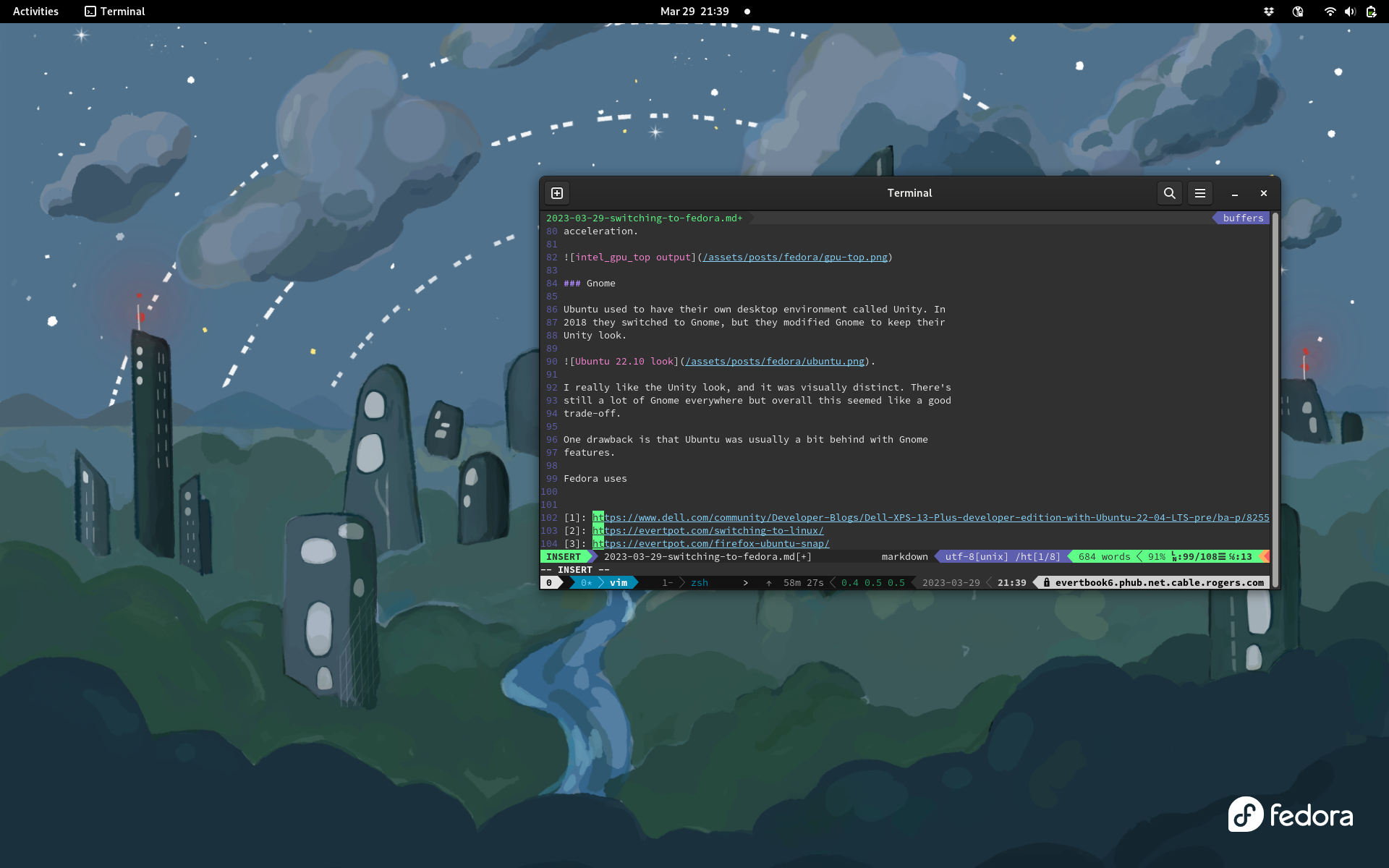Switching to Fedora from Ubuntu
It seems like every 7-8 years I’m switching operating systems. In 2006 I first started using Apple, because it was just so damn cool to have a well working Unix-like system. (I’ll never forget you Snow Leopard).
In 2015 I switched to Ubuntu. Apple’s Software seemed to hit rock bottom at this point from a quality perspective, and hardware seemed to go obsolete at a rate I hadn’t seen before. Fed up paying a premium price for a sub-par product, it was time for a change.

Ubuntu’s fall
Ubuntu was the obvious choice. I want something that just works, and Dell’s XPS 13 Developer Edition ships with Ubuntu which means hardware support from Dell itself. Breath of fresh air and fast as hell. The experience was similar to what people have been saying about the new M1 chips. But it’s fast because of software, not hardware.
But something changed with Ubuntu in recent years. I think linux users have a thicker than usual skin when it comes to software issues and are willing to look past more things. But Ubuntu’s quality has been consistently falling. I was being worn down, and it seems to be a common sentiment in my bubble.
The best example is Ubuntu’s package manager Snap. A pretty good idea, I like the branding too but the execution hasn’t been there. Ubuntu users have been effectively beta-testing this for years. Just to give you an idea I made a giant list of bugs that I ran into when Ubuntu switched Firefox from apt to Snap.
To be honest I feel a bit bad ragging on Ubuntu, because without knowing anything about how the project and Canonical is run, my intuition is that the steam is just kind of running out for them. Ubuntu feels ‘depressed’, but maybe it’s all in my head.
Onto Fedora
So I pledged to try something new in 2022, and it took me another 14 months to find the energy and motivation to actually follow through.
I went for Fedora. Named after a fashion faux pas, it seems to be on the #2 spot for desktop linux. It’s funded by Red Hat, and seems to have a focus on keeping it’s packages very up to date, which I like and why I originally switched from Debian to Ubuntu!
I’m a week and a bit in, and here are my first impressions.
Installation
Installation was super smooth. I always forget to make a separate /home
mount, so it took a while to move everything to an external disk and back.
The one thing I always forget to move is my MySQL databases, and today was no exception.
Non-free stuff
Fedora does not ship with things that aren’t open source. Nothing against that philosophy (awesome in fact), but personally I don’t mind adding some binaries for a better experience.
I miss Ubuntu’s Additional Drivers tool, because it told me what to install. I’m sure the drivers I need are available for Fedora, but I don’t know what to look for which makes me slightly worried my computer is not running optimally. Battery feels worse but that could also be my imagination.
Video in Firefox didn’t work at all in stock Fedora. I had to install
ffmpeg to get it to barely function, but then I discovered RPM Fusion, where
I got an even better ffmpeg, plus gstreamer and Intel drivers and I can now watch
beautiful smooth 4K video, and confirmed with intel_gpu_top that I’m using
hardware acceleration.
Gnome
Ubuntu used to have their own desktop environment called Unity. In 2018 they switched to Gnome, but they modified Gnome to keep their Unity look.
This felt like a good move, because it let them kept their look while taking advantage of all the Gnome plumbing.
One drawback is that Ubuntu was usually a bit behind with Gnome features.
Fedora uses stock Gnome. As a result there’s more consistency overall, and it’s nice to have the latest features. I miss the strong visual identity Ubuntu has though. It sets itself apart from Mac and Windows.
I’m sure I can customize Fedora to be more fun, but if I’m being real with myself I haven’t changed my desktop background in 10 years, and so this will never happen.
Flatpak
The only thing that Flatpak had to do to be better than Snap was to not remind me of its existence unless I’m installing something, and so far it’s done that. Flathub is nice, and I love the idea of developers not having to repackage for every distro under the sun.
Bugginess
Fedora does generally feel more stable. Fewer background processes pegged at 100%. 3rd party application support doesn’t seem as good on first sight. I had to find workarounds for KeeppassXC and Element to not crash all the time.
This is no fault of the Fedora team, but it does tell you something about how much Fedora is on other people’s radars. If developers test 1 linux distro, it will be Ubuntu.
Software Center app
I falsely assumed that the Software Center application was buggy due to Ubuntu’s Snap changes, but it also hangs all the time in Fedora.
The solution is to kill the gnome-software process if you want
to use ‘Software’ more than once per session. Apparently this has
been an issue for at least 12 months
Would I recommend Fedora?
Things are never perfect, but even with some of the issues I ran into I’m very happy I switched. It’s hard to describe, but things feel more solid.
To get to this state I did have to put in some work and research, but not at a level of recompiling kernels.
If you are comfortable googling, using the terminal for some commands and interpreting an occasional error message I would now recommend Fedora over Ubuntu.
If you are not a technical user or programmer-adjacent, I think Ubuntu is still going to be the choice with the least amount of friction. In large I think this is simply because it is the biggest, has the most eyes and the most support.
I’m excited though. Fresh start!


